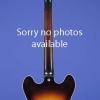The King of the Jazz Guitars…
Weighs 6.10 lbs. and has a nut width of just under 1 11/16 inches and a scale length of 25 1/2 inches. Perfectly book-matched carved spruce top with a two-piece book-matched curly maple back and curly maple sides, two-piece book-matched curly maple neck with center mahogany strip, and multi-bound ebony fretboard with a small, graceful point at the end of the fretboard, 20 frets, and inlaid pearl block position markers. Nine-ply binding on the top of the guitar, five-ply binding on the back, and single-bound f-holes. Multi-bound headstock with the "Gibson" pearl logo inlaid diagonally across the face of the headstock and with the pearl "L-5" flowerpot inlay. Bound plastic bell-shaped truss-rod cover. Black-painted headstock rear face with widow's peak. Individual Kluson Sealfast tuners with bell-shaped metal buttons. Style number ("L5-C") and serial number ("A-33284") on the orange oval printed label inside the bass f-hole. Original multi-bound tortoiseshell pickguard. Rosewood bridge with pre-set compensating saddle on rosewood base and gold-plated flat plate tailpiece with engraved "L 5" and small hole at the bottom center (for allen wrench tension adjustment). All hardware gold-plated. This guitar is in near mint (9.25) condition.
There is some very minor finish checking and a couple of small playing-wear spots on the sides of neck around the third fret. Otherwise this wonderful example is in as near mint and totally original condition as one could ever wish for. Complete with its original matching number hang-tag and housed in the original Gibson brown hardshell case with purple plush lining (8.75).
Although the serial number "A 33284" corresponds with a shipping date of around April 1960, this guitar was obvoiusly made sometime in either late '59 or very early '60 as the neck profile is oh-so-typical of that wonderful '59 neck that we all long for…
"Timeless elegance. A jazz icon. The inspirational archtop guitar. These are just a few of the descriptions that fit Gibson’s L-5. Add to those a historical antecedent: the L-5 in various forms has been in constant production since late 1922, longer than any Martin, Gretsch, Epiphone, or National model...Originally conceived by acoustic engineer Lloyd Loar, the L-5 was the first guitar with design principles incorporated from carved instruments of the cello family. It represented a complete break from existing guitar design. Sporting simple appointments such as dot fingerboard inlays and a dark sunburst finish, the guitar was elegantly finished with a pearl “flower pot” inlaid in the headstock below the Gibson logo, and a karat at the end of the fingerboard. The timing of the L-5’s introduction was nearly perfect since the guitar at that time was growing in popularity, but had yet to graduate from being just an instrument of vocal accompaniment to use in ensemble and orchestra settings. The 16" wide L-5 provided volume lacking in Gibson’s roundhole archtop guitars, and by the early 1930s the instrument had grown in popularity and sales enough to cause rivals Epiphone and Gretsch to introduce their own carved top/back instruments. In ’34, Gibson upped the ante by introducing 'advanced' versions of the L-5, which increased the width of both the upper and lower bouts. While the advanced version was a little fancier, with larger fingerboard inlays and more binding, there was still an elegance to the details that made the instrument stand out. Certainly by the early ’40s the L-5 was a staple in jazz band and orchestral settings. At 17" across the lower bout, it was a perfectly sized instrument. Loud enough for orchestral use, but not so large and difficult to handle as Gibson’s Super 400 or the Epiphone Emperor, the L-5 was extremely popular among musicians in jazz, country and western, and large orchestras. Demand for the guitar was such that after World War II it was one of the first models rushed back into production, even though some materials were in short supply. There were other detail changes along the way; a natural-finish option, a cutaway option, fancier tailpiece, and better tuners, but the instrument was otherwise unchanged until the original non-cutaway model was discontinued in 1958...The cutaway model soldiered on until ’82 when it was supplanted by the L-5CES...Today, the L-5 is one of the most collectible guitars from Gibson’s pre-war period. It is sought not only for its historical importance, but also for sound and playability, for its elegant design, and for its influence on the music of yesterday and today" (Eric C. Shoaf, "Gibson L-5: Loyd Loar's Timeless Masterpiece").
Translate:


